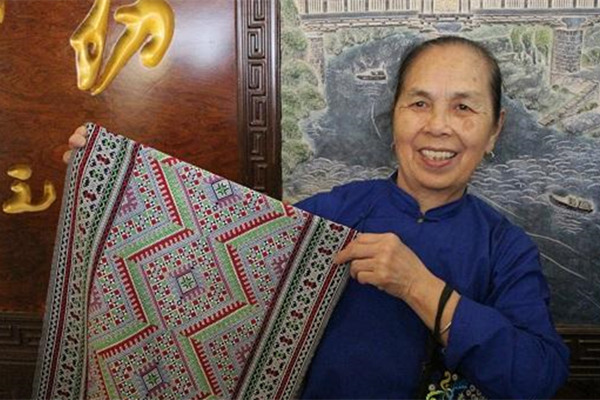
Li Tianmei showcases Dongjin in Tongdao Dong autonomous county, in Hunan province, August 30, 2016. (Photo by Wan Lijun/provided to chinadaily.com.cn)
Dongjin, or the Dong brocade, has recorded the history of the Dong ethnic group for thousands of years. Now it is helping them move out of poverty.
The technique, well-known for its rich colors and exquisite patterns, has been passed on from mothers to daughters of Dong ethnic group for more than 2,000 years. It was listed as one of the state-level intangible cultural heritage list in 2008.
Li Tianmei, a resident of Lanxiang village, Tongdao Dong autonomous county in Hunan province, is one of the few national inheritors of the technique.
Li, 69, started to learn the craft from her mother when she was 12 years old. By the age of 15, she could independently complete the whole process of making Dongjin.
"When weaving, you have to bind silk threads and tapes of various colors to your waist and legs while moving feet and hands at the same time," Li said. "Pieces of Dongjin slowly come to life with the squeaks of the loom."
The process is complicated and has more than 10 steps, including cotton ginning, spinning and dyeing, with the most difficult being counting the threads.
"The hundreds of thousands of threads must be counted and organized carefully one by one, otherwise the patterns will be distorted and the surface uneven," Li said.
Due to unstable income from weaving, the pressure to earn money was mainly shouldered by her husband. One time her husband was so stressed that he set her loom on fire.
Bu Li never gave up her passion. She began adding various modern elements into the old art.
"Dongjin is a craftsmanship left by our ancestors. We can't afford to lose it. We are responsible for attracting more young weavers to carry it forward," She said.
Aiming to encourage more inheritors, she established a school in the village to teach residents the skill with the support of local government in 2009.
The work is labor-intensive and time-consuming. Weaving a scarf may sometimes take a skilled worker up to one month. Therefore the price is also very high.
Li said that her family could make 3,000 to 4,000 yuan by farming. After the establishment of the institute, her average annual family income reached 40,000 yuan ($5,990).
So far, more than 3,000 women have learned the craft from Li. Many of them now make Dongjin in their spare time at home, earning extra income ranging from 10,000 to 60,000 yuan every year.
Many designers from foreign countries, including Italy and Netherlands, also come to her school to study the ancient art.
Moreover, the Tongdao county government has established a company to promote Dongjin. Besides selling the products in physical stores, the company is exploring a broader market through e-commerce.
"With the support of the government, I will continue to pass on the technique," Li said.




















































